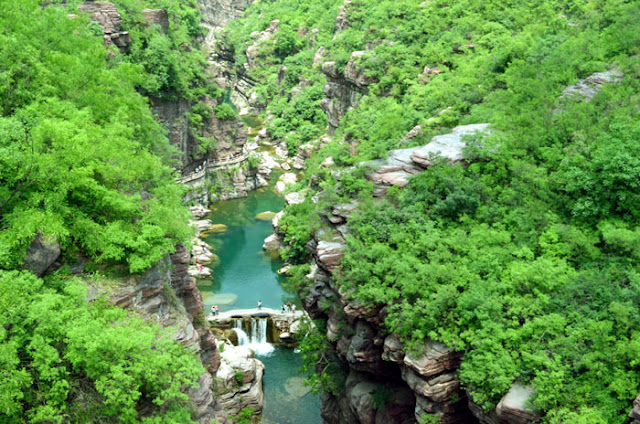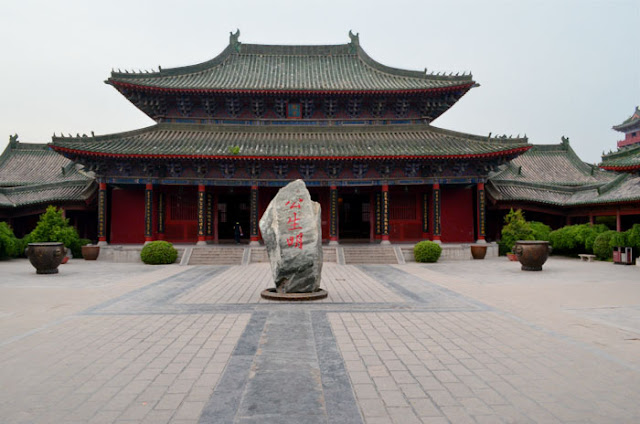We continued our trip to Dengfeng Town and Shaolin Monastery in Songshan (嵩山). Of course, Shaolin Monastery was the highlight of our fourth day tour. We started our journey from Xinmi at 9 am, and reached Dengfeng at around 9:30 am. Dengfeng has numerous Chinese martial art schools and many of these schools claimed to have certain connection to Shaolin. Of course, we couldn't know how true it was, but for sure, Shaolin has successfully developed "kungfu ecomony" at Dengfeng.
Our first stop at Dengfeng- Shi Xiaolong Martial Art School to watch a wushu show by a group of school children. The students there had performed very well. However, we had expected more. Well, maybe we watched too much movies about Shaolin kungfu, such as the one produced by Jason Scott Lee.
Songshan can be seen from Dengfeng town.
Shi Xiaolong Martial Art School houses a few thousand of students. They have martial art practices integrated into their curriculum. We found the short form of the school name in English was pretty cool- SLSXLWY.
The wushu performance.
Photo with the performers.
We took our steamboat buffet lunch at Shaolin International Hotel, Dengfeng. The meal was nice with wide variety of choices. The normal price for the meal was CNY58 per person but for us, it was included in our tour package.
Travel by bus, Shaolin Monastery is 30 minutes from Dengfeng Town. Surrounded by Songshan (嵩山) or Song Mountain, the view there was stunning. Built in year 495, the temple has been established for more than 1500 years. Legend says the temple was the birth place of kungfu.
Driven by the expectation to see old temples and sifus with awesome kungfu, we met with the biggest disappointment of our tour- we found relatively new temple buildings with a few young monks selling books, souvenirs etc., watching over the temple, and playing with their smart phone under the shady roof. The scene was totally out of register with the Shaolin Temple in our mind.
Later, we found out that Shaolin Monastery was partly destroyed by bandits (in 1359), rebels (in 1641), several times by the rulers, and almost totally devastated by a warlord in 1928. Most of the buildings that we saw was built after 1980. The only real relics that we can see in the monastery is the Hall of Thousand Buddhas (千佛殿), which was built in 1588.
Travel by bus, Shaolin Monastery is 30 minutes from Dengfeng Town. Surrounded by Songshan (嵩山) or Song Mountain, the view there was stunning. Built in year 495, the temple has been established for more than 1500 years. Legend says the temple was the birth place of kungfu.
Driven by the expectation to see old temples and sifus with awesome kungfu, we met with the biggest disappointment of our tour- we found relatively new temple buildings with a few young monks selling books, souvenirs etc., watching over the temple, and playing with their smart phone under the shady roof. The scene was totally out of register with the Shaolin Temple in our mind.
Later, we found out that Shaolin Monastery was partly destroyed by bandits (in 1359), rebels (in 1641), several times by the rulers, and almost totally devastated by a warlord in 1928. Most of the buildings that we saw was built after 1980. The only real relics that we can see in the monastery is the Hall of Thousand Buddhas (千佛殿), which was built in 1588.
Through the visit, we also learned that Shaolin kungfu is about practice and meditation (禅武).
It is not a kind of wushu or fighting skill. Shaolin kungfu is not exist overnight, but a result of enhancement and refinement over a long period of time. We found a good video showing the history of Shaolin in Chinese. Today, monks are still practicing kungfu as their daily routine, but not at the tourist area.
We paid CNY100 to enter the gate of Shaolin, and the two ways ticket with electric car for CNY20. Taking the electric car is advised as the monastery is quite a distance away from the main entrance. As the temple complex at the tourist area are relatively new, it will be less interesting to visit the place without a guide to tell us the story behind the building. Of course, we can always read more about Shaolin Monastery and its history prior to our visit. We spent three solid hours in Shaolin Monastery and Pagoda Forest.
We paid CNY100 to enter the gate of Shaolin, and the two ways ticket with electric car for CNY20. Taking the electric car is advised as the monastery is quite a distance away from the main entrance. As the temple complex at the tourist area are relatively new, it will be less interesting to visit the place without a guide to tell us the story behind the building. Of course, we can always read more about Shaolin Monastery and its history prior to our visit. We spent three solid hours in Shaolin Monastery and Pagoda Forest.
After lunch, time to pay our visit to Shaolin Monastery 30 minutes from Dengfeng Town. The hills around the temple area can be clearly seen from the carpark (upper left). A stone nearby the entrance with words carved "the culture of Shaolin is a heritage of humanity" by Jiang Zhemin- former General Secretary of the Communist Party of China (upper right). We walked through the gate to the Shaolin Monastery (lower right) to reach the electric car station.
The mountain gate (山门) with the words Shaolin Si caligraphed by Emperor Kangxi of Qing Dynasty in 1704.
The shady walkway with steles is dubbed as beilin (碑林) or the forest of steles (upper left). A 1500 years old Ginko tree is an attraction to the tourists at the end of beilin (upper right). Steles erected in 728 AD stated the history of how the 13 monks helped Emperor Li Shimin of Tang Dynasty won his battle over his rivals (lower right). The scripture room is now a house of a reclining Buddha.
A stone stele written by Jinyong (金庸), a famous Chinese novel writer.
The buildings around the monastery are beautiful, but relatively new with less historical value.
Two very old antiques in the monastery- the wok and the stone mill in front of the scripture room (upper row). Lixue Ting was built according to the plan of Bodhidharma Bower (达摩庭) (lower left), with the sculpture of Bodhidharma placed not far from the bower.
Hall of Thousand Buddhas (千佛殿) is located deep inside the monastery (upper row). The 48 depressions on the floor were believed to be formed by the "qi" channelled by the monks when they practiced kungfu in this hall (lower right). The picture of 500 luohan was drawn on the wall of the hall.
Talin (塔林) or Pagoda Forest is 10 minutes walk from Shaolin Monastery. The place serves as tombs for eminent monks and abbots. Pagoda Forest is filled with pproximately 240 pagodas, with the oldest one built in 618 AD. The whole Pagoda Forest was fenced.
The pagodas were built with either three, five or seven levels, representing the status of the deceased.
Beautiful scenery at Songshan. The shopping area at the gate of Shaolin was not very attractive. We can get items with low price if our bargaining skill is good.
Ranked top among five great mountains in China (五岳山), Songshan is dotted by many temples and breathtaking sceneries. Our original plan was to visit Sanhuang Zhai (三皇寨) by cable car, not far from Shaolin Monastery. However, the cable car was closed for service during our visit so we chose to skip Shanhuang Zhai monastery and continued our journey to Luoyang (洛阳).
Now, if you ask, is Shaolin Monastery worth a visit? We would say yes. However, we would advise to skip the kungfu show at Dengfeng and go straight to Sanhuang Zhai Monastery after visiting Shaolin Monastery and Pagoda Forest. Without cable car, visiting Sanhuang Zhai will be time and energy consuming. See this page for more information about Sanhuang Zhai.
5:30 pm, we reached Luoyang City. We paid a visit to Guanglin Temple (关林), the burial site of Guanyu's head. Guanyu (关羽) was a great general of Shu (蜀国) during Three Kingdom's period (after Han Dynasty). He was famous due to his loyalty and his mastery of military strategies. He was beheaded by his rival from Wu Kingdom (吴国) with his head sent to another rival- Caocao of Wei Kingdom (魏国). Out of respect, Caocao (曹操) buried Guanyu's head with great honour outside of Luoyang around 1800 years ago.
Guanyu is the only legendary figure respected by Confucians, Buddists, and Taoists, whose the tomb had been patronized by many emperors, and worshipped as god by both gangsters and police forces in Hong Kong movies. Again, in order to pay our respect to this legendary hero, we need to pay CNY40 of entrance fee first.
The entrance of Guanlin (upper left) leads to the temple of Guanyu, which was built around 1600 AD (upper right). According to history, Guanyu used double swords and spear in battlefield instead of 70 kgs-dragon-sword as described in novel (lower left). Guanyu mastered the military strategies from books he read. His face was originally pale, but was painted red by his worshippers as a reflection of his personality.
A gazebo built by Emperor Kangxi in 1666 AD with a wooden stele declares the sanctification of Guanyu.
Is Guanlin a must visit site in Luoyang? Yes, only if you are a big fan of this hero. In fact, there was little information about Guanyu available in the temple, and it would be quite boring if we came without prior knowledge about him. For those who are worshipping Guanyu as a god, it might be a disappointment to know the truth that the beheaded god. Isn't it a better choice to worship the person who beheading the god? Well, sometimes, the religion matter might not appear to be in alignment with our logic.
We dined at a very special restaurant in Luoyang- no ice cube provided. Anyway, the food served was nice. We stayed in Lee Royal Hotel Mudu, Luoyang and experienced local Chinese style massage there. The hotel has impressive lobby, comfy room and nice breakfast. We were just a bit not used to the open concept washroom and bath tube (transparent glass partitions without curtain).
We found the truth of Shaolin Monastery and General Guanyu in our day 4 trip. Day 5, we had Longmen Grottoes (龙门石窟) and Museum of Luoyang Eastern Zhou Royal Horse and Chariot Pits (洛阳天子驾六博物馆) in our itinerary.
[Kaifeng, Henan One Day Trip] [Yuntai Mountain, Truly a World Heritage]
[Henan Museum and Huang He Scenic Area]
[Dengfeng Shaolin Temple and Guanlin Temple] [Longmen Grottoes & Charriot Luoyang]
[The Magnificent Terracotta Army of Qin Dynasty]
[Henan Museum and Huang He Scenic Area]
[Dengfeng Shaolin Temple and Guanlin Temple] [Longmen Grottoes & Charriot Luoyang]
[The Magnificent Terracotta Army of Qin Dynasty]




































































